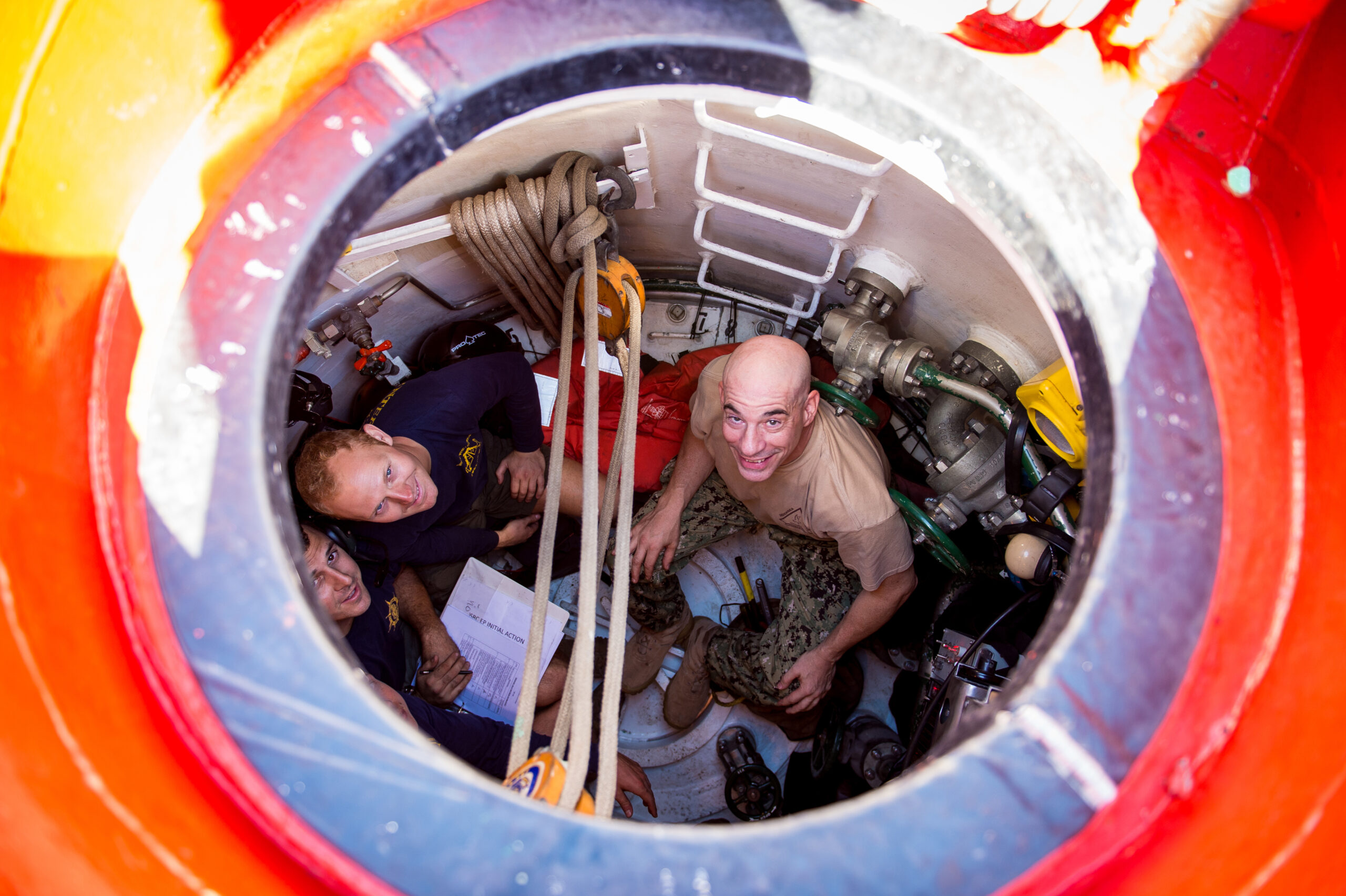When a submarine runs out of oxygen, the people onboard will start to experience the effects of hypoxia, or oxygen deprivation.

Credit: www.wearethemighty.com
Effects Of Oxygen Depletion On Submarine Crew
When a submarine runs out of oxygen, the crew will begin to experience the effects of hypoxia, or oxygen deprivation. This can lead to symptoms such as headaches, confusion, and nausea. It is essential to have emergency reserves to provide enough oxygen until the situation is resolved.
A submarine relies on a constant supply of oxygen to sustain the crew members while they are submerged underwater. However, what happens if a submarine runs out of oxygen? Let’s explore the potential effects of oxygen depletion on the submarine crew:
- Loss of consciousness and potential death due to suffocation: When a submarine runs out of oxygen, the crew members may start experiencing a decrease in oxygen levels, leading to loss of consciousness. Without immediate intervention, this can result in suffocation and ultimately, potential death. The lack of oxygen can lead to severe consequences for the crew members on board.
- Possible use of inert gases as an alternative to oxygen: To avoid the detrimental effects of oxygen depletion, some submarines are equipped with inert gas systems. These systems replace the oxygen-rich atmosphere with inert gases, such as nitrogen or argon. The key purpose behind utilizing inert gases is to displace the oxygen and reduce the risk of fire and explosion in the event of a breach in the submarine’s hull. However, it’s important to note that inhaling inert gases for a prolonged period can have its own set of risks.
Remember, in the case of oxygen depletion in a submarine, immediate action must be taken to ensure crew safety. The potential consequences are severe, highlighting the criticality of maintaining a continuous supply of oxygen.
Duration Before Submarine Runs Out Of Oxygen
If a submarine runs out of oxygen, the crew will start experiencing the effects of hypoxia, or oxygen deprivation. This can lead to symptoms such as headaches, nausea, confusion, and eventually loss of consciousness. It is crucial for submarines to have proper oxygen supply systems in place to prevent such situations.
Examination Of The Duration A Submarine Can Go Without Air:
- The duration before a submarine runs out of oxygen varies depending on several factors. Here’s an analysis of these key factors:
Analysis Of Factors That Affect Oxygen Consumption:
- Factors affecting the duration a submarine can go without air include:
- Submarine size and crew capacity: Larger submarines with more crew members typically have bigger oxygen storage capacities, allowing for a longer duration without air.
- Oxygen generation systems: Some submarines have oxygen generators that can produce oxygen from water electrolysis. These systems can help sustain the crew by continuously producing oxygen.
- Oxygen storage capacity: The amount of oxygen stored onboard the submarine significantly impacts how long it can function without replenishment. Submarines with larger oxygen storage capacities can sustain the crew for extended periods.
- Crew size and activity levels: The number of crew members and their activity levels influence oxygen consumption rates. Submarines with fewer crew members and lower activity levels can conserve oxygen for longer periods.
- Environmental conditions: The depth at which the submarine operates and the surrounding water temperature affect the rate of oxygen consumption. Deeper depths and colder temperatures generally increase oxygen consumption.
- Emergency scenarios: In the event of an emergency, such as a breach in the submarine’s hull or loss of power, oxygen consumption can become more critical. Emergency protocols and procedures can affect the duration the submarine can go without air in such situations.
Understanding these factors is vital for assessing the duration a submarine can go without air. While specific figures may vary, submarines are designed to have sufficient oxygen reserves to sustain the crew during their operational missions.
Methods Of Oxygen Supply In Submarines
If a submarine runs out of oxygen, the crew will start to experience the effects of hypoxia, or oxygen deprivation. This can lead to symptoms such as headaches, nausea, confusion, and ultimately, loss of consciousness. Therefore, it is crucial for submarines to have proper methods of oxygen supply in order to maintain the safety of the crew.
Different Sources Of Oxygen Supply In Submarines:
- Pressurized tanks: Submarines often carry pressurized tanks filled with oxygen. These tanks store a large amount of oxygen, ensuring a continuous supply for the crew. They can be refilled when the submarine resurfaces.
- Oxygen generators: Another method of oxygen supply is through oxygen generators. These generators produce oxygen by electrolysis, which is the process of breaking down water molecules to release oxygen. This self-sustaining system provides a constant source of oxygen without the need for external refilling.
- Oxygen canisters: Some submarines utilize oxygen canisters, which release oxygen through a chemical reaction. These canisters contain a substance that produces oxygen when heated. Although they may not offer a long-term oxygen supply, they can serve as a backup option in case the primary methods fail.
Comparison Of Pressurized Tanks, Oxygen Generators, And Oxygen Canisters:
- Pressurized tanks:
- Provide a large storage capacity of oxygen.
- Need to be refilled when the oxygen supply runs low.
- Require careful monitoring to prevent leaks or malfunctions.
- Oxygen generators:
- Produce oxygen through the electrolysis of water.
- Can continuously supply oxygen without the need for refilling.
- Require regular maintenance to ensure proper functioning.
- Oxygen canisters:
- Release oxygen through a chemical reaction.
- Serve as a backup option in case of emergencies.
- Have a limited capacity and need to be replaced after use.
The methods of oxygen supply in submarines vary, with each having its advantages and considerations. Pressurized tanks offer a large storage capacity but require regular refilling. Oxygen generators provide a self-sustaining oxygen supply but need maintenance. Oxygen canisters serve as a backup option but have limited capacity.
These different sources ensure that submarines can maintain a sufficient oxygen supply, even in challenging conditions.
Frequently Asked Questions For What Happens If A Submarine Runs Out Of Oxygen
How Long Can A Submarine Go Without Air?
A submarine can go without air for a limited time until the crew starts experiencing oxygen deprivation.
How Long Before The Submarine Runs Out Of Oxygen?
If a submarine runs out of oxygen, the crew will start to experience oxygen deprivation, also known as hypoxia.
How Do People In Submarines Get Oxygen?
People in submarines get oxygen through either pressurized tanks, oxygen generators, or oxygen canisters that release oxygen through a chemical reaction.
How Much Oxygen Is Left In The Lost Submarine?
The exact answer is unknown as the oxygen levels in the Lost submarine are not publicly available.
What Happens When A Submarine Runs Out Of Oxygen?
When a submarine runs out of oxygen, the people onboard will start to experience the effects of hypoxia, or oxygen deprivation.
Conclusion
If a submarine runs out of oxygen, the consequences can be grave. As the oxygen levels decrease, the crew onboard will start experiencing the effects of hypoxia, or oxygen deprivation. This can lead to symptoms such as headaches, nausea, confusion, and ultimately loss of consciousness.
Without prompt intervention, the crew could face a tragic outcome. However, modern submarines are equipped with various methods to prevent oxygen depletion. These include pressurized tanks, oxygen generators, and emergency reserves. In the event of power loss and the inability to produce oxygen, crews can even resort to lighting an oxygen candle or utilizing electrolysis.
These measures aim to ensure that submarines have an adequate oxygen supply, preventing the dire consequences of running out. Overall, the survival of the crew in such a situation hinges on the effectiveness of these systems and the timely response to the oxygen supply issue.


